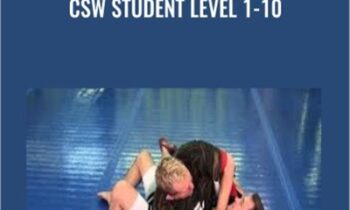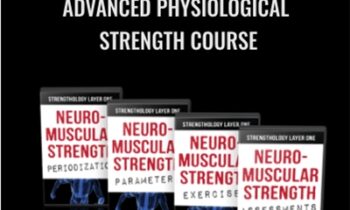$149.00 Original price was: $149.00.$44.00Current price is: $44.00.
Digital Download: You will receive a download link via your order email
Save up to 85% compared to Salepage prices. In addition, earn additional points. Save more on your next order.
Please contact email: wixzip.cs@gmail.com if you have any questions about this course.
 Purchase this course you will earn 44 Points worth of $4.40
Purchase this course you will earn 44 Points worth of $4.40Elevate your skills with the Susan B. Young – Sensory Integration & ‘Smart’ Treatment Strategies When Formal Testing Isn’t Possible course, available for just $149.00 Original price was: $149.00.$44.00Current price is: $44.00. on Utralist.com! Browse our curated selection of over 60,000 downloadable digital courses across diverse Health and Medical. Benefit from expert-led, self-paced instruction and save over 80%. Start learning smarter today!
 Susan B. Young – Sensory Integration & ‘Smart’ Treatment Strategies When Formal Testing Isn’t Possible
Susan B. Young – Sensory Integration & ‘Smart’ Treatment Strategies When Formal Testing Isn’t Possible
How do you help a child grow when they’re too overwhelmed by their senses?
From ADHD to Autism Spectrum Disorder, loud noises can become painful and too much stimulation can make it difficult to concentrate – yet your young clients are expected to fully participate in school, at home and in their community.
Sometimes the “normal” treatments don’t fit the child in front of you and when every child’s needs are different, it can feel overwhelming or frustrating for you, too.
But what if you could expose your young clients to sensory stimulation in a structured way that allow them to adapt, process and react to sensations effectively – a treatment modality that goes beyond the formal assessments?
In this brand-new online course, Sensory Integration & ‘Smart’ Treatment Strategies: When Formal Testing Isn’t Possible, you’ll get this special training to evaluate when Sensory Integration (SI) is a good fit, and learn to create unique and challenging activities that help your client process these overwhelming situations through repetitive activities.
Discover carefully designed, tailored physical activities that incorporate Sensory Integration (SI) – from balance to movement to structured exposure – that keep your client’s attention and how to you can accommodate treatment strategies to be done in therapy or at home. As one of the original researchers of the Praxis Test (SIPT) certification process, your expert instructor, Susan Young will walk you step-by-step through techniques that can fit your client’s exact needs, so you can create a sensory approach that fits multiple environments and helps your clients get back to fully participating in everyday activities.
Sensory processing disorders can be debilitating for those who experience them.
Overstimulation, trouble following directions or focusing attention can make it difficult to engage in day-to-day activities. Formal tests often require these things making it challenging for children with sensory deficits to meet the standards. This online course will expand your knowledge of sensory processing activities and enhance your effectiveness to work with these children!
Learn how to identify which of your clients’ shortfalls have a sensory integration foundation and what treatment techniques to use to improve their quality of life.
This workshop will step you through the key components of Sensory Integration (SI) and how you can apply it to your treatment approach with the children you work with in your practice.
Understanding Sensory Integration & Your Client
Discover the neurological foundations of SI, including primary sensory systems, receptors, neurological tracts and brain locations of sensory systems. You’ll dive into how each system is stimulated and types of sensory integration dysfunction associated with each system so you can create a better foundation for treatment.
Assessing & Treating Your Young Client with Sensory Integration
This part of the workshop will show you how to identify behaviors which are sensory and plan treatment strategies to help them more fully participate in school, community and home activities. You’ll analyze case studies using a sensory integration frame of reference vs developmental or motor, distinguish between sensory-based and non sensory-based behaviors and categorize observations into sensory processing categories.
Discover various assessments, including how to formulate interview questions for parents/teachers to gain sensory information related to participation in everyday life. You’ll cluster responses into “diagnostic groups” to make them easier to tackle during treatment.
From your various assessments, you’ll be able to design treatment sessions based on Ayres SI principles and create a customized, well-rounded treatment plan. Learn how to analyze sensory aspects of therapy equipment and modify activities to match needs of the child, while developing sensory diets for use at home and school, and sensory stories to enhance participation in daily activities. Writing goals and objectives while measuring progress will be covered as well!
Documentation: Maximizing Reimbursement & Access to Services
Learn how to document progress in functional terms, and write goals and objectives which enable access to services in schools and clinics. This section will cover evaluations, progress and discharge reports, along with maximizing reimbursement for therapy!
Susan B. Young, OTD, OTR/L, FAOTA, is a faculty member for the USC/WPS Sensory Integration and Praxis Test (SIPT) certification process. She was one of the original researchers for the SIPT under the supervision of Dr. A. Jean Ayres. She has many years of clinical practice including owning Children’s Therapy Group in Kansas City, a multidisciplinary private practice primarily serving children with sensory integration deficits. Dr. Young’s career includes director of OT and PT at Childrens Mercy Hospital, program director of the Occupational Therapy Program at Rockhurst University, and associate professor of OT at Belmont University.
She is an adjunct professor of OT at Belmont University. Graduate (MSOT and OTD) students have gained pediatric competence from Dr. Young’s expertise in the classroom and the lab experiences. She teaches workshops internationally as well as nationally. She is author of “Movement Is Fun”, a program of movement activities for preschool children based on sensory concepts.
Sale Page: https://catalog.pesi.com/sales/bh_c_001300_sensoryintegration_organic-72073
Archive: https://archive.fo/wip/15tue
Delivery Method
Be the first to review “Susan B. Young – Sensory Integration & ‘Smart’ Treatment Strategies When Formal Testing Isn’t Possible” Cancel reply
Cultivate continuous growth with the Susan B. Young – Sensory Integration & ‘Smart’ Treatment Strategies When Formal Testing Isn’t Possible course at Utralist.com! Unlock lifetime access to premium digital content, meticulously designed for both career advancement and personal enrichment.
- Lifetime Access: Enjoy limitless access to your purchased courses.
- Exceptional Value: Benefit from savings up to 80% on high-quality courses.
- Secure Transactions: Your payments are always safe and protected.
- Practical Application: Gain real-world skills applicable to your goals.
- Instant Accessibility: Begin your learning journey immediately after buying.
- Device Compatible: Access your courses seamlessly on any device.
Transform your potential with Utralist.com!
Related products
Health and Medical
= 28 Points
Health and Medical
= 27 Points
Health and Medical
= 29 Points
Health and Medical
= 85 Points
Health and Medical
= 43 Points
Health and Medical
= 28 Points
Health and Medical
= 18 Points
Health and Medical
‘Quantum’ Chakra Clearing and Balancing Series – Jonette Crowley
= 52 Points




 Susan B. Young – Sensory Integration & ‘Smart’ Treatment Strategies When Formal Testing Isn’t Possible
Susan B. Young – Sensory Integration & ‘Smart’ Treatment Strategies When Formal Testing Isn’t Possible






Reviews
There are no reviews yet.